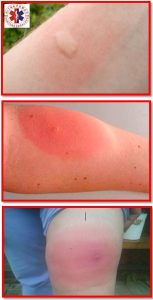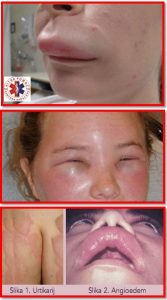INSECT BITE
INSECT BITE
Insects are the most numerous and diverse group of animal species on Earth. Of the numerous insects, only a small number of them cause health problems in humans, either to serve as carriers of certain diseases (mosquitoes, flies, lice, ticks,…), or to cause allergic reactions , wasps, hornets,…) .As with all other diseases, the motto applies here: Better to prevent than to cure. Prevention is carried out by applying insect repellents to the body - the so-called. repellents and adequate behavior in nature (avoiding strong perfumes, not consuming sweetened and colored drinks, juicy fruits and vegetables, closing trash cans, examining the body after a stay in nature, etc.).
Reactions to insect bites can be:
local: which take place at the site of the sting, in the form of redness and swelling, which may be accompanied by itching and pain.
systemic: which manifest as an allergic reaction
In local reactions, the use of cold compresses and antihistamines in the form of a cream or spray and possibly a corticosteroid cream is sufficient in self-help.
Sistemske odnosno alergijske reakcije su puno ozbiljnije, pa ćemo njima posvetiti malo više pažnje.
Allergic reactions to insect bites can manifest in four stages: The first stage is a hives rash (urticaria). Second stage - with urticaria, swelling, nausea, vomiting and diarrhea occur. The third stage is characterized by difficulty and audible breathing, wheezing, difficulty swallowing and confusion. The fourth stage (Anaphylaxis) is characterized by a drop in pressure, loss of consciousness, dark blue skin and mucous membranes.
Allergic reactions in our climate most often occur to the sting of bees, wasps and hornets. During stings, bees leave a sting at the place of the sting, while wasps and hornets keep the sting and can sting several times, their venom is stronger, so their stings are all the more dangerous.
Treatment of allergic reactions to insect bites should begin as soon as possible with the use of self-help - removing the sting (it is necessary to remove the sides and not vertically, because in this way the remaining venom is expelled into the body), by applying cold compresses. you should seek the help of a family doctor.

In case of symptoms of the third and fourth stage, it is necessary to immediately call the emergency medical service at number 124 and monitor the vital parameters of the victim according to the CABD scheme.
Sometimes, due to a strong allergic reaction, the airways can be completely closed, so artificial respiration will have no effect.
If you are far from the HMP, in a remote area, do not waste time waiting for the HMP team. If possible, place the victim in the car in the most comfortable position possible, warm him, calm him down and, in coordination with the dispatcher, start the transport to meet the ambulance team.

